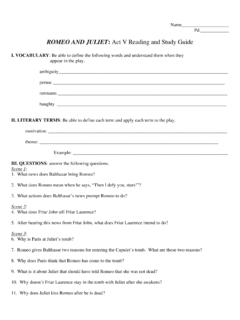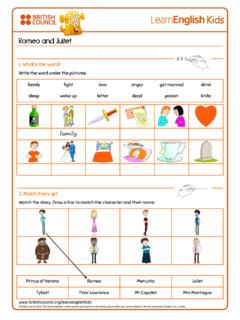Transcription of Creativity in the Primary Classroom - Juliet Desailly
1 Creativity IN THE Primary CLASSROOMC reativity in the Primary iCreativity in the Primary i24/11/2011 11:23:5124/11/2011 11:23:51 Creativity in the Primary iiCreativity in the Primary ii24/11/2011 11:24:0324/11/2011 11:24:03 Creativity IN THE Primary CLASSROOMJ uliet DesaillyCreativity in the Primary iiiCreativity in the Primary iii24/11/2011 11:24:0324/11/2011 11:24:03 Juliet Desailly 2012 First published 2012 Apart from any fair dealing for the purposes of research or private study,or criticism or review, as permitted under the Copyright, Designs andPatents Act, 1988, this publication may be reproduced, stored ortransmitted in any form, or by any means, only with the priorpermission in writing of the publishers, or in the case of reprographicreproduction, in accordance with the terms of licences issued bythe Copyright Licensing Agency. Enquiries concerning reproductionoutside those terms should be sent to the Publications Ltd1 Oliver s Yard55 City RoadLondon EC1Y 1 SPSAGE Publications Teller RoadThousand Oaks, California 91320 SAGE Publications India Pvt LtdB 1/I 1 Mohan Cooperative Industrial AreaMathura RoadNew Delhi 110 044 SAGE Publications Asia-Pacific Pte Ltd3 Church Street#10-04 Samsung HubSingapore 049483 Library of Congress Control Number: 2011931167 British Library Cataloguing in Publication dataA catalogue record for this book is available from the British LibraryISBN 978-1-85702-763-4 ISBN 978-1-85702-764-1 (pbk)Typeset by Kestrel Data, Exeter, DevonPrinted in Great Britain byPrinted on paper from sustainable resourcesCreativity in the Primary ivCreativity in the Primary iv24/11/2011 11:24:0424/11/2011 11:24.
2 04 CONTENTSA bout the author viAcknowledgements viiIntroduction 1 Part One: What Is Creativity ? 91 The key elements of Creativity 112 Creativity in Education: History and theoretical background 27 Part Two: A Creative Child in a Creative Classroom 433 Building the skills to work creatively 454 Establishing the ethos 59 Part Three: A Creative Teacher 755 What makes a creative teacher? 776 Key skills for the creative teacher 91 Part Four: A Creative Curriculum 1077 Planning for creative outcomes 1098 Medium term planning for creative outcomes 1229 Case studies: Creativity in practice 137 Conclusion and Forward Planning 150 References, websites and further reading 153 Index 158 Creativity in the Primary vCreativity in the Primary v24/11/2011 11:24:0424/11/2011 11:24:04 ABOUT THE AUTHORJ uliet Desailly has worked in Education for over thirty years.
3 Having trained originally as a specialist drama teacher and then working in Theatre-in-Education, when she became a Primary teacher she brought a range of different teaching and learning methods to her worked in Inner London Primary schools for over twenty years, refining and adapting the Primary curriculum to suit the children she taught integrating social and emotional skills within the curriculum, emphasising the children s identity and culture and raising self-esteem by providing an inclusive curriculum for all learners. As well as her teaching and work in Theatre-in-Education Juliet has been a Humanities adviser and a deputy head teacher. After seven years as a lecturer at the Institute of Education on the Primary PGCE course, she now works as a consultant in Creativity and curriculum has written a large amount of educational material, including two series of Infant History for BBC Radio and materials for the Education Department s Social and Emotional Aspects of Learning (SEAL) resource.
4 She has recently published her first children s book, Ma at s Feather, a story set in Ancient Egypt and a set of accompanying cross-curricular lesson in the Primary viCreativity in the Primary vi24/11/2011 11:24:0524/11/2011 11:24:05 ACKNOWLEGEMENTSHad I known what the year I have spent writing this book was going to throw at me I might well not have embarked on the task. That I have achieved it is in no small part due to the enormous help, encouragement and support of my family. More thanks than I can say are due to my husband, Alan, and daughters, Rossy and Nancy, for their patience when I was stressed, for reading and commenting wisely on the manuscript, for their interest and enthusiasm and, not least, for their huge moral support when the task seemed beyond school teachers are by nature borrowers and adaptors of ideas and information. I have spent over thirty years in the company of other teachers and students, listening, watching, discussing and always picking up ideas to try to adapt to my own uses.
5 As such, I cannot possibly remember or give credit individually to all those amazing teachers young and old whose Creativity and inventiveness have contributed to the ideas in this book. All I can say is a blanket thank you to every child I have taught, every student I have observed and every colleague I have worked with for all I have gained from you. I hope I have passed it on usefully in my turn. To John Cook and Jill Bonner, the head teachers who particularly fostered and valued my Creativity as a teacher, many my colleagues at the Institute of Education have been generous with their interest and support. Particular thanks go to Anne Robertson, the Primary PGCE course leader, for giving her time so generously; she read the manuscript as it was produced and gave enormously helpful advice and encouragement, particularly on the ideas for the Further Study sections.
6 Finally, many thanks to James Clark, Monira Begum and all the staff at Sage Publications for their patience, advice and hard work in the production of this in the Primary viiCreativity in the Primary vii24/11/2011 11:24:0524/11/2011 11:24:05 INTRODUCTIONWhat do we want a Classroom in a Primary school in the second decade of the 21st century to look like? Children sat in rows looking at the board? Children involved in investigations and experimentation? Children working silently and alone? Children debating enthusiastically in groups? Or perhaps all of these things at different times? And what do we mean by a Classroom ? Could the learning be happening outside, in the community or a natural environment?As teachers, we need to help prepare young people for life in a rapidly changing society where they can be innovative, responsive and fulfilled.
7 We will need the ability to use methods of teaching and learning within a curriculum that will make that schools have already been adapting what and how they teach and how the learning is organised to make it more holistic, more engaging, more personalised and more creative. The next few years will see a new National Curriculum being embedded in England with consequent opportunities and challenges for teachers to provide the best and most appropriate learning opportunities for the children they teach. The White Paper on education, announcing the new curriculum, stated it creates scope for teachers to inspire . It envisaged teachers taking greater control over what is taught in schools, innovating in how they teach and developing new approaches to learning (DfE 2010: 40). While much in the aims of the new National Curriculum emphasises a core of essential knowledge it also recognises the importance of giving teachers the freedom to use their professionalism and expertise in order to Creativity in the Primary 1 Creativity in the Primary 124/11/2011 11:24:0524/11/2011 11:24:052 Creativity IN THE Primary Classroom help all children realise their potential (DfE 2011: 1).
8 In criticising the previous National Curriculum for squeezing out room for innovation, Creativity , deep learning and intellectual exploration (DfE 2010: 40) it implicitly supports these aspects. This could be the time for teachers to take the opportunity to develop and practise teaching methods that inspire young people and allow for deeper find a balance between all the constituent parts of both the National Curriculum and the broader curriculum, to find teaching methods that inspire and motivate young people to learn deeply and well will be a challenge for teachers joining the profession, as it will be to more experienced teachers. They will need to be flexible and to learn new skills in the way they plan and teach but it will also give the opportunity for teaching and learning that are exciting and fulfilling for children and teachers creativityCreativity has always proved hard to define, both in education and in its wider contexts.
9 However, it has also been something that has been thought valuable and worth promoting. The first aim of the 1999 National Curriculum (known as Cu r r ic u lu m 2 0 0 0) st ate s, t he c u r r ic u lu m shou ld e n a ble pupi l s to t h i n k c r e at i vel y and critically, to solve problems and to make a difference for the better. It should give them the opportunity to become creative, innovative, enterprising and capable of leadership to equip them for their future lives as workers and citizens (DfEE/QCA 1999). During the first decade of the 21st century there were several developments designed to foster and promote Creativity , including a joint-department review called Nurturing Creativity in Young People (DCMS/DfES 2006) and the report and teachers resources Creativity : Find it, Promote it (QCA 2005). Teachers have long been aware of the importance to children s learning of the spark of Creativity in children s descriptions and art work: It s like a rainbow was caught and shining in his eye.
10 They see how children invent methods for problem solving or find patterns in data or images. They relish the enthusiasm and intense concentration children show when involved in exploring materials or mixing ingredients but these moments of Classroom magic have often seemed at odds with the drive to raise standards. The research and understanding of the benefits of Creativity and creative learning are still often sidelined or the final report of the Cambridge Primary Review, which was published in 2010, the director of the review, Professor Robin Alexander, commented that in submissions to the review the words creative and Creativity appeared .. more frequently than almost any others . He continued that the words invariably were regarded positively. The words were also used somewhat loosely (Alexander 2010: 226). This loose terminology sees the term Creativity used to describe arts subject areas, cross-curricular planning, working without Creativity in the Primary 2 Creativity in the Primary 224/11/2011 11:24:0524/11/2011 11:24:05 INTRODUCTION 3preconceived outcomes, creative teaching, children s Creativity .







